 An amplifier is one of the most commonly used electronic devices in the world. It’s a basic building block of a vast number of circuits, and comes in various forms. Amplifiers can be defined simply as an electronic device that increases the power of a signal. In other words, it increases the amplitude of a signal, and makes it stronger than the given input.
An amplifier is one of the most commonly used electronic devices in the world. It’s a basic building block of a vast number of circuits, and comes in various forms. Amplifiers can be defined simply as an electronic device that increases the power of a signal. In other words, it increases the amplitude of a signal, and makes it stronger than the given input.
Although this sounds simple in theory, amplifiers have a lot of parameters and conditions in the real world. Amplification is never perfectly efficient, there are always losses, distortion and noise to deal with.
Thus, there are a whole load of amplifiers created, that work best in different situations. Not all amplifiers provide optimal output in all situations, and there’s always cost factors to consider. So here’s all the types of amplifiers and all you need to know about them!
Important Characteristics of an Amplifier
The quality of an amplifier is measured by a series of specifications called figures of merit. They are as follows:
-
- Bandwidth: The frequency range at which the amplifier can operate.
- Noise: The amount of unwanted extra information included in the output.
- Skew Rate: The maximum rate of change of output.
- Gain: Perhaps the most important, the ratio between the magnitudes of input and output signals.
- Stability: The ability to provide constant and reliable output.
- Linearity: The degree of proportionality between input and output signals.
- Efficiency: Another very important characteristic, it is the ratio between the output power and power consumed.
- Output Dynamic Range: Ratio between the largest and smallest useful output levels.
Types of Amplifiers
Although amplifiers are sometimes classified according to input and output parameters (we’ll get to that), there are 4 basic types, which are:
- Current Amplifier: As the name suggests, an amplifier that makes the given input current higher. It is characterized by a low input impedance and high output impedance.
- Voltage Amplifier: An amplifier that amplifies given voltage for a larger voltage output. It is characterized by a high input impedance and low output impedance.
- Transconductance Amplifier: An amplifier that changes output current according to changing input voltage.
- Transresistance Amplifier: An amplifier that changes output voltage according to changing input current. It is also known as a current-to-voltage converter.
Apart from the basic types, there are several other types of amplifiers, categorized by their operation, application or characteristics. Some of them are:
- Power Amplifiers: Although not technically a type, power amplifier is a general term that refers to the amount of power provided by the power supply circuit or the amount of power delivered to the load. It is usually used in the last output stages of a circuit. Examples include: audio power amplifiers, servo motor controllers, push-pull amplifers and RF power amplifiers. Again, we’ll look at the classifications of power amplifiers specifically in a little bit, since they’re very important.
- Operational Amplifiers (Op-Amps): Another very important type, an op-amp is an integrated circuit that acts as a voltage amplifier, and has differential input. It has a positive and negative input, but a single output with very high gain. Originally, op-amps were created using valves.
- Please refer to this link to know more about operational amplifier MCQs
- Valve (or) Vacuum Tube Amplifiers: An amplifier that uses vacuum tubes to provide an increased power or voltage output is known as a valve (or) vacuum tube amplifier. As mentioned above, op-amps were originally of the valve type, but were replaced by ICs once they got cheaper, in smaller applications at least. In high power applications, they’re still in use because of their cost effectiveness and output quality. They are used in radar, military, high power radio and UHF transmitter applications.
- Transistor Amplifiers: A well known type of amplifier, specially to engineering students, a transistor amplifier is a multi configuration high output amplifier that uses transistors as the working base. These include bipolar junction transistors (BJTs) and metal oxide semiconductor field-effect transistors (MOSFETs).
- Klystron: A special type of linear beam vacuum tube, used as an amplifier in high radio frequencies. It is highly precise and used in large scale operations, usually comes under Microwave amplifiers.
- Instrument Amplifiers: Specially designed amplifiers to amplify sound, voice or music. Used mainly in musical instrument applications.
- Distributed Amplifiers: Amplifiers that use transmission lines to temporarily split the input and amplify each segment individually are called distributed amplifiers. They’re commonly found in oscilloscopes.
These are just a few types of amplifiers in use right now, and it’s pretty obvious that each of them has an area of specialization, more or less. There are a vast number of applications in the world, and there’s an amplifier for almost all of them.
Types of Power Amplifiers
Now, the most well known types of amplifiers aren’t the ones described above, but power amplifier types. Often confused as the only categories of amplifiers, they are actually types of power amplifiers and are classified on the basis of the proportion of the input cycle during which the amplifier is giving an output. The proportion of the active input cycle is also known as conduction angle. For example, a 360 degrees conduction angle means that the device is always on, a conduction angle of 180 degrees means that the device is on only for half of each cycle. Now, the different types of power amplifiers are described below:
Please refer to this link to know more about Transistor Audio Power Amplifiers MCQs
Class A Power Amplifier
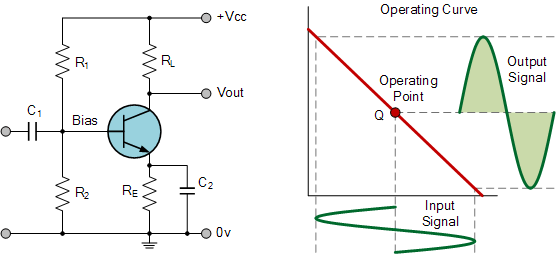
An amplifier that conducts during the full cycle, or has a conducting angle of 360 degrees is known as a Class A power amplifier. It is the simplest and most common type of power amplifier, because of low signal distortion levels. It has its fair share of disadvantages though, and is generally not used in high power applications. Some of its characteristics are:
- Low signal distortion levels
- Simple design
- The device is always conducting due to amplifying element bias
- No turn on time or charge storage problems
- Quite stable
- Highest linearity
- Low efficiency due to being on all the time, around the vicinity of 25-50%
- High heat output during operation
Class B Power Amplifier
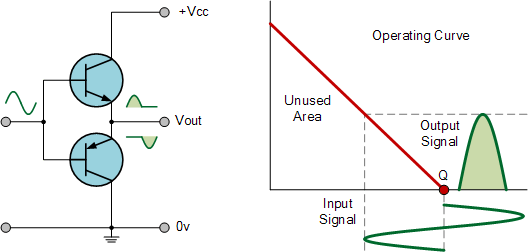
Class B Power Amplifiers, unlike Class A, work for only half of each input cycle, which means they have a conducting angle of 180 degrees. In simple words, these amplifiers amplify only half of the input cycle. On paper that probably sounds unusable, but in reality, it’s quite different. A Class B amplifier consists of a positive and negative transistor, which run alternatively, amplifying the positive and negative cycle respectively, which in the end is combined to form a full output cycle. It’s a more efficient design, and has its own set of advantages and disadvantages compared to the Class A power amplifier. It’s characterized by:
- Uses 2 complementary transistors, one each for the positive and negative cycle
- Much higher efficiency, around 75-78.5%
- Lesser heat output
- Stable and reliable
- Requires at least 0.7 V to start conducting, which means anything under it doesn’t register, so cannot be used for precise applications
- Combines 2 half cycles to form one full cycle
Class AB Power Amplifier
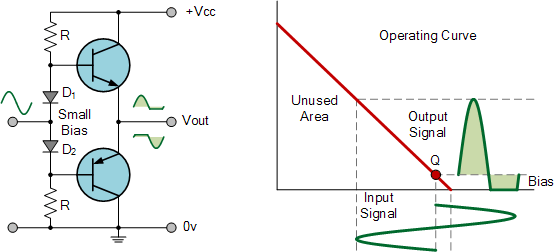
A Class AB Power Amplifier is, as the name suggests, a mix of Class A and Class B power amplifiers. Like the Class B amplifier, it also uses 2 conducting elements (transistors), but they both run at the same time. This eliminates the ‘dead zone’ from -0.7 V to + 0.7 V seen in the Class B power amplifier. But in this case, while each transistor conducts for more than a half cycle, they conduct less than a full cycle completely. So the conduction angle is somewhere around 180 degrees and 360 degrees, commonly shown as 270 degrees in some cases. Here are it’s characteristics:
- Uses 2 transistors that work together
- Each transistor is active for slightly less than a full cycle but more than a half cycle
- Combines Class A and Class B characteristics
- No crossover distortion
- Fairly efficient, at around 50-60%
- Most common audio amplifier design
Class C Power Amplifier
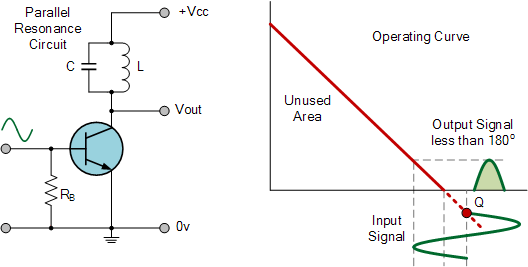
A Class C Power Amplifier is something of an oddity compared to the other 3 types listed above. It’s the most efficient, but has the lowest operating cycle and linearity. Since it’s heavily biased, it stays on for less than half of an input cycle, and thus has a conducting angle somewhere around the vicinity of 90 degrees. This results in the high efficiency mentioned above, but also causes high distortion in the output signal, so Class C amplifiers are usually not used as audio amplifiers. They’re used in certain radio frequency applications where efficiency is key. Its most important characteristics are:
- Least linear among power amplifiers
- Very high efficiency of around 80-90%
- High output distortion
- Two operating modes, tuned and untuned
- Low power dissipation
Class D Power Amplifier

And finally, we have Class D Power Amplifiers, which sometimes aren’t considered among the 4 mentioned above. It’s a non-linear switching amplifier in which the two transistors function as switches instead of linear gain devices. It converts the analog signal into digital via pulse width modulation, pulse density modulation or something similar before being amplified. The end result is a cycled output with high efficiency and gain, without too much distortion. Although originally used to control motors, they are now used as audio power amplifiers as well. Contrary to popular belief, the ‘D’ in the name doesn’t stand for digital, because the converted signal is pulse width modulated analog, and not pulse width modulated digital. It is characterized by:
- High efficiency, can theoretically be 100%
- Low power dissipation
- Low power consumption
- More complex than other types of power amplifiers
- Precise and accurate output
And that’s it about amplifiers! We hope that the types of amplifiers as well as the types of power amplifiers are clearer now, and if you have any questions about the information, feel free to comment below!
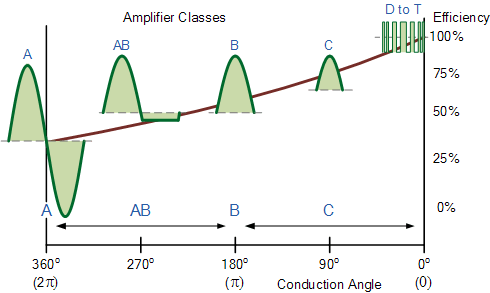
Please refer to this link to know more about Differential Amplifier & Single Tuned Amplifier.
Please refer to this link to know more about Multi Stage Transistor Amplifier MCQs & Single Stage Transistor Amplifier MCQs.
Pictures Courtesy: Electronics-Tutorials.ws, Extron